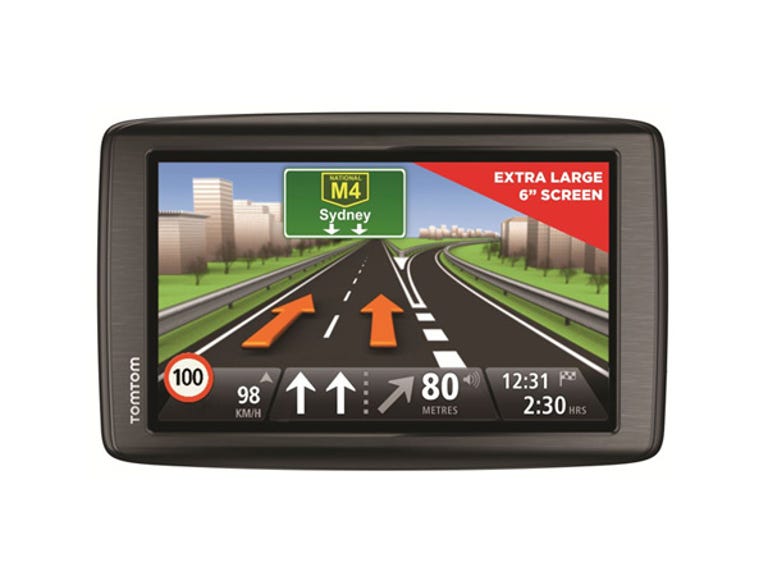 Why You Can Trust CNET
Why You Can Trust CNET TomTom Via 620 review: TomTom Via 620
We love the Via 620's high-resolution display, but we'd argue that the 6-inch display is simply too large and a potential safety hazard.
Design
Quarter acre blocks, TVs that can be measured in metres and Hummers that require their own postcode — all these things fit the "bigger is better" school of thought. Now, you can add to that list the TomTom Via 620. It looks much like the other models in the Via range of GPS units, but this one's big, really big, thanks to its 6-inch touchscreen. The tapered hard plastic body does a good job of disguising the unit's 2.4cm thickness, while the faux brushed metal bezel hints, ever so slightly, at the finer things in life.
The Good
The Bad
The Bottom Line
For the 6-inch behemoth of a screen, TomTom has wisely decided to increase the pixel count to 800x480, up from the resolution on regular units of 480x272. This upgrade is most noticeable when flicking through the menus or entering addresses as text, and graphics no longer have that jagged look. Aside from featuring smoother lines and curves, TomTom hasn't added any snap, crackle or pop to the plain, but easy to read, map screen.
The built-in speaker projects instructions and warnings nicely enough, and it has a good volume range that doesn't descend into a mire of static when you flick the volume up. The EasyMount suction cup is, as ever, wonderful in its simplicity and compactness, and won't get lost amongst the glove box detritus, as it's built into the device. The supplied in-car charging kit consists of a USB cigarette port and a micro-USB cable; though by no means a killer feature, this combo allows drivers to recharge their favourite smartphone when not using the GPS, or easily replace their charging gear should one part be lost.
Features
Aside from the screen that's so big you can eat your (small) dinner off it, what does the RRP of AU$249 buy you? Not as many headline features as we'd hoped, unfortunately. Notable absentees from the spec sheet include TomTom's proprietary subscription-based Live traffic and information service and Bluetooth hands-free — the latter being the item we most pined for.
The features list includes what we'd consider to be our bare minimum requirements for a GPS in 2012. There's spoken street names, lane guidance for pretty much every multi-lane street in capital cities and full screen junction view graphics for motorway and highway exits, as well as some important intersections.
Speed limit info proved to be pretty comprehensive, at least in the city and suburbs where most of us reside, and, helpfully, includes 40km/h school zone warning system, which pop up only on weekdays. We'd caution against trusting the included speed, red light and safety camera warnings exclusively, though, as some cameras aren't present, while others only register when you're travelling in certain directions.
Performance
During our testing, in and around Sydney, mapping errors were rare, indeed — some of the credit here must go to the Whereis mapping data, although, as we've discovered on recent Navteq-powered Garmin units, this isn't quite the advantage it used to be. The remaining kudos goes to TomTom's MapShare crowd sourcing service that allows users to identify map errors, like incorrect road restrictions or speed limits, and once verified by a team at TomTom or shared by enough users, these are downloaded via the MyTomTom app to TomTom devices when they're plugged into a PC or Mac.
The Via 620 is able to navigate you from A to B, but there are no leaps or bounds made in the area of route calculation. Pitted against a person with reasonable local knowledge, the Via 620 will usually come off second best, picking routes that mainly utilise main roads. Although, the TomTom does have, from time to time, an odd and unfathomable wanderlust for narrow side streets. That said, route calculation and re-calculation is pretty speedy.
In a plethora of test vehicles, from tiny two-seater convertibles to full-size family sedans, we found that the Via 620's 6-inch screen much too large — indeed, in some smaller vehicles, we felt 5-inch screens were already too big for the cars they inhabited. The cause for our concern is that hiding behind the Via 620's body is a large chunk of road space, and potentially kids, cars and other obstructions, that we can no longer see. Quite often, we caught ourselves peering around the unit, just to make sure that we were in the clear.
Conclusion
We love the Via 620's high-resolution display, but we'd argue that, unless you're driving a Land Cruiser, Hummer or some other gargantuan vehicle, the 6-inch display is simply too large and a potential safety hazard. We'd recommend saving the cash and opting for a smaller 4.3-inch or 5-inch model, or using spending your money on a model with Bluetooth hands-free, such as the AU$229 Via 180.


